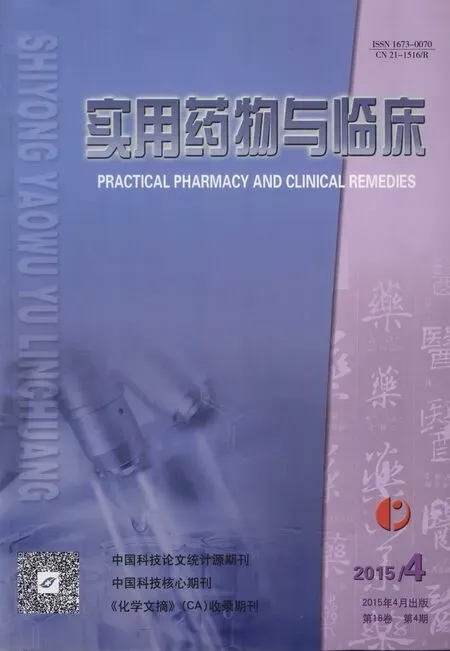德谷胰岛素—治疗糖尿病的新选择
2015-04-03李华荣
朱 路,李华荣
德谷胰岛素—治疗糖尿病的新选择
朱 路,李华荣
糖尿病需要长期的药物治疗和患者自我饮食运动调节。无论1型还是2型糖尿病,随着病程的发展,注射外源性胰岛素都是必须的治疗手段。胰岛素有低血糖风险,理想的胰岛素治疗应该在改善血糖控制的同时,降低低血糖的危险。德谷胰岛素是一种新型超长效基础胰岛素,皮下注射后,半衰期接近25 h,只需1次/d给药,且其在到达稳态时没有胰岛素累积现象,峰谷比较其他基础胰岛素低,因此,低血糖风险更低。本文对德谷胰岛素的研究现状进行综述。
糖尿病;低血糖;德谷胰岛素
0 引言
糖尿病是一种全球性的慢性代谢性疾病,需要终生治疗。在遗传或环境因素的作用下,胰岛B细胞无法分泌胰岛素或分泌量不足,就会引发糖尿病[1]。1型糖尿病患者的胰岛B细胞已经丧失,会降解蛋白质和脂肪作为替代的能量来源,很容易导致酮症酸中毒。2型糖尿病患者体内存在胰岛素抵抗,其病情会随着胰岛B细胞功能减少而逐渐恶化。早期2型糖尿病患者会以锻炼、控制饮食及结合口服降糖药为主要治疗手段[2],但是随着病程的发展,无论1型糖尿病还是2型糖尿病,胰岛素都是必须的治疗手段之一。
1 胰岛素治疗的不良反应
胰岛素通过控制血糖,预防高血糖及心血管病变。但是,胰岛素的不良反应-低血糖是治疗的障碍。正常人体内,当出现低血糖时,胰岛α细胞可以分泌胰高血糖素来平衡调控,但在糖尿病患者体内,这种调控机制是缺失或者无效的。因此,治疗时,血糖降低超出生理需要时,容易发生医源性低血糖。Goto等[3]对903 510例2型糖尿病患者进行为期5年的跟踪调查,发现0.6%~5.8%的患者经历过严重的低血糖反应。神经性低血糖(大脑短期的血糖降低)会影响神经细胞功能,改变大脑的功能和行为。长期、频繁的神经性低血糖会导致意识丧失,大脑损伤,甚至死亡。因为调控机制的缺失,1型糖尿病患者发生低血糖的几率高于2型糖尿病患者。
低血糖会导致胰岛素治疗的不坚持性。有报道,33.3%的已经使用胰岛素的患者放弃胰岛素治疗[4-5]。对低血糖的顾虑影响了患者的积极性,也延误了胰岛素治疗的时机。对于低血糖风险小的胰岛素的需求已经越来越强烈。
2 基础胰岛素的现状
在降糖药物浓度达到峰值时,容易发生低血糖。胰岛素治疗的最终目的是还原生理胰岛素平缓、持续的分泌功能。但是当前广泛使用的基础胰岛素会产生峰值,容易引起低血糖。中性鱼精蛋白锌胰岛素不仅有峰值,即使在相同时间、相同剂量注射也会出现药效学的不同与波动,虽然甘精胰岛素和地特胰岛素有较小的峰值和波动,且低血糖风险较低[6],但在药效学和药动学方面仍未达到满意效果,其需要每天在相同时间点注射,影响了长期的坚持性[4],仍然不能作为理想型基础胰岛素的代表[7]。
3 德谷胰岛素
德谷胰岛素是新型的可溶性、超长效基础胰岛素,已经在欧洲、日本、印度、墨西哥上市,在美国处于批准上市前阶段。德谷胰岛素有独特的药理作用[8],作用时间超过42 h[9]。在临床试验中,德谷胰岛素与甘精胰岛素效果相当,但低血压风险更低[10-13]。
3.1 结构特点 在胰岛B细胞中,内源性胰岛素以六聚体结合锌的形式存在。当分泌时,它迅速分解为具有生物活性的单聚体,后者迅速吸收入体内循环,但六聚体或者更大的聚合物吸收缓慢。这个理论已用于指导研发胰岛素类似物,延迟外源性胰岛素从注射部位的吸收。德谷胰岛素被设计为多个六聚体的混合体[8],通过改变人胰岛素分子的一个氨基酸,即去掉其B链第30位氨基酸,再通过1个谷氨酸连接子,将1个16碳脂肪二酸的侧链连接到B29位上。另外在德谷胰岛素的制剂中,添加苯酚、锌,使各个六聚体相互作用结合,形成稳定的多六聚体,从而达到缓慢释放进入体内循环的目的。
3.2 部分药代学与药动学特点 德谷胰岛素对于1型或2型糖尿病的半衰期均接近25 h,对于1型糖尿病患者,其持续时间>42 h[9,14-15]。由于其长效机制,每天注射1次可以在2~3 d内达到稳态血药浓度,具有非常平滑稳定的药效学特点[16]。另外,与甘精胰岛素比较,德谷胰岛素的降血糖效果的个体化差异小[17]。在特定人群,如>65岁的老人、儿童及肝肾损伤者中,德谷胰岛素的药动学特征也十分稳定[18-20]。胰岛素累积是指重复多次给药后,胰岛素水平堆积到一个不适当的高浓度。这种情况通常出现在当常规剂量无法控制血糖,给予额外的大剂量时,这种过度用药容易导致血糖过低[21]。对于长效胰岛素,是否引起胰岛素累积而导致低血糖风险,是必须考虑的因素。德谷胰岛素的血药浓度从给药当天开始上升,2~3 d内达到稳态浓度[16],其半衰期相对于给药间隔时间越长,峰谷比值越低[21],越稳定。在处于稳态时,给药间隔长或短的影响会被缓冲,不会引起胰岛素累积。
德谷胰岛素有2个浓度:100 U/mL、200 U/mL,2个浓度的生物等效性相同[22]。高浓度并未使药代学和药动学参数改变。因为在皮下注射后,注射部位会形成一个储存库,从中缓慢释放单聚体进入毛细血管而发挥作用。单聚体的释放率(而不是胰岛素浓度)决定了德谷胰岛素的作用特性[8,14,17]。
3.3 安全与效用临床试验 在德谷胰岛素的Ⅲ期临床试验过程中,通过研究其药效学和药动学参数发现,与其他基础胰岛素比较,无论1型还是2型糖尿病,德谷胰岛素的低血糖风险较低[10,11,13,23-27]。在与甘精胰岛素的对比中,德谷胰岛素的低血糖发生率较低(尤其在治疗期后的维持期)[12]。
在一项为期52周、随机、开放、无劣性的临床试验中,一组每周3次早餐前或晚餐时使用德谷胰岛素,另外一组使用甘精胰岛素1次/d,结果两组患者糖化血红蛋白(HbA1c)比较差异无统计学意义[28],说明德谷胰岛素3次/周的效果与甘精胰岛素1次/d相同。
Mathieu等[24]将糖尿病患者分为3组,1组按不同的给药间隔(8~40 h)给予德谷胰岛素,2组给予德谷胰岛素1次/d,3组给予甘精胰岛素1次/d。结果显示,虽然在第52周三组都有低血糖现象出现,但灵活时间给药德谷胰岛素组夜间低血糖发生率显著降低。表明德谷胰岛素给药间隔在8~40 h内,灵活的给药时间并未给安全性带来影响,但前提是给药间隔不能少于8 h[15]。
另外,德谷胰岛素的剂量不是固定不变的。在开始滴定期时,容易发生低血糖,故在滴定期剂量应该少于试验中的使用剂量。对于使用其他基础胰岛素的患者,过渡到德谷胰岛素时,如原来1次/d使用甘精胰岛素的患者,改用德谷胰岛素时剂量无变化;但原来2次/d使用鱼精蛋白锌等胰岛素的患者,改用德谷胰岛素后,剂量需要减少20%;或者HbA1c<8%时,也需要减量使用。同时使用口服降糖药物时,剂量也需要调整。需要根据血糖变化,做到个性化给药。
3.4 获益人群 调查显示,患者放弃胰岛素治疗的理由包括:工作繁忙,旅行,饮食不规律,压力,在公众场所难以注射,不能坚持准时注射。因此,灵活的给药时间是特定人群坚持胰岛素治疗的前提,特别是经常处于不同的时区而需要倒时差的患者,以及需要照顾的老年患者。相比甘精胰岛素,德谷胰岛素在老年患者中的夜间低血糖更低[29]。
4 结语
医源性低血糖是控制血糖的障碍,对治疗糖尿病有很大的影响。另外,每天准时给药也为糖尿病患者带来不便。德谷胰岛素作为新一代的超长效、可溶性、基础胰岛素,血药浓度平稳,给药时间和部位灵活[27]。其药理作用减少了夜间低血糖的风险,且安全性并未因为灵活的给药时间而受到影响。这对于特定的糖尿病患者,比如旅行中、工作时间不固定、生活不能自理者,是十分有价值的。而且,其安全、灵活性等特点并没有因种族不同而改变[30]。随着研究的更加深入,德谷胰岛素将有可能成为新一代超长效基础胰岛素的代表及首选药物。
[1] Ding L,Gysemans C,Mathieu C.β-Cell differentiation and regeneration in type 1 diabetes[J].Diabetes Obes Metab,2013,15(Suppl 3):98-104.
[2] American Diabetes Association Standards of medical care in diabetes-2013[J].Diabetes Care,2013,36(Suppl 1):S11-S66.
[3] Goto A,Arah OA,Goto M,et al.Severe hypoglycaemia and cardiovascular disease:systematic review and meta-analysis with bias analysis[J].BMJ,2013,347:f4533.
[4] Peyrot M,Barnett AH,Meneghini LF,et al.Insulin adherence behaviours and barriers in the multinational global attitudes of patients and physicians in insulin therapy study[J].Diabet Med,2012,29(5):682-689.
[5] Davies MJ,Gagliardino JJ,Gray LJ,et al.Real-world factors affecting adherence to insulin therapy in patients with Type 1 or Type 2 diabetes mellitus:a systematic review[J].Diabet Med,2013,30(5):512-524.
[6] Simon AC,De Vries JH.The future of basal insulin supplementation[J].Diabetes Technol Ther,2011,13(Suppl 1):S103-S108.
[7] Garber AJ.Will the next generation of basal insulins offer clinical advantages[J].Diabetes Obes Metab,2014,16(6):483-491.
[8] Jonassen I,Havelund S,Hoeg-Jensen T,et al.Design of the novel protraction mechanism of insulin degludec,an ultra-long-acting basal insulin[J].Pharm Res,2012,29(8):2104-2114.
[9] Wang F,Surh J,Kaur M.Insulin degludec as an ultralong-acting basal insulin once a day:a systematic review[J].Diabetes Metab Syndr Obes,2012,5:191-204.
[10]Garber AJ,King AB,Del Prato S,et al.Insulin degludec,an ultra-longacting basal insulin,versus insulin glargine in basal-bolus treatment with mealtime insulin aspart in type 2 diabetes (BEGIN Basal-Bolus Type 2):a phase 3,randomised,open-label,treat-to-target non-inferiority trial[J].Lancet,2012,379(9825):1498-1507.
[11]Heller S,Buse J,Fisher M,et al.Insulin degludec,an ultra-longacting basal insulin,versus insulin glargine in basal-bolus treatment with mealtime insulin aspart in type 1 diabetes (BEGIN Basal-Bolus Type 1):a phase 3,randomised,open-label,treat-to-target,non-inferiority trial[J].Lancet,2012,379(9825):1489-1497.
[12]Ratner RE,Gough SC,Mathieu C,et al.Hypoglycaemia risk with insulin degludec compared with insulin glargine in type 2 and type 1 diabetes:a pre-planned meta-analysis of phase 3 trials[J].Diabetes Obes Metab,2013,15(2):175-184.
[13]Zinman B,Philis-Tsimikas A,Cariou B,et al.Insulin degludec versus insulin glargine in insulin-naive patients with type 2 diabetes:a 1-year,randomized,treat-to-target trial (BEGIN Once Long)[J].Diabetes Care,2012,35(12):2464-2471.
[14]Heise T,Nosek L,Bttcher SG,et al.Ultra-long-acting insulin degludec has a flat and stable glucose-lowering effect in type 2 diabetes[J].Diabetes Obes Metab,2012,14(10):944-950.
[15]Aye MM,Atkin SL.Patient safety and minimizing risk with insulin administration-role of insulin degludec[J].Drug Healthc Patient Saf,2014,6:55-67.
[16]Heise T,Nosek L,Roepstorff C.Distinct Prandial and Basal Glucose-Lowering Effects of Insulin Degludec/Insulin Aspart (IDegAsp) at Steady State in Subjects with Type 1 Diabetes Mellitus[J].Diabetes Ther,2014,5(1):255-265.
[17]Heise T,Hermanski L,Nosek L,et al.Insulin degludec:four times lower pharmacodynamic variability than insulin glargine under steady-state conditions in type 1 diabetes[J].Diabetes Obes Metab,2012,14(9):859-864.
[18]Kupěová V,Arold G,Roepstorff C,et al.Insulin degludec:pharmacokinetic properties in subjects with hepatic impairment[J].Clin Drug Investig,2014,34(2):127-133.
[19]Kiss I,Arold G,Roepstorff C,et al.Insulin degludec:pharmacokinetics in patients with renal impairment[J].Clin Pharmacokinet,2013,53(2):175-183.
[20]Korsatko S,Deller S,Mader JK,et al.Ultra-long pharmacokinetic properties of insulin degludec are comparable in elderly subjects and younger adults with type 1 diabetes mellitus[J].Drugs Aging,2013,31(1):47-53.
[21]Heise T,Meneghini LF.Insulin stacking versus therapeutic accumulation:understanding the differences[J].Endocr Pract,2013,20(1):75-83.
[22]Korsatko S,Deller S,Koehler G,et al.A comparison of the steady-state pharmacokinetic and pharmacodynamic profiles of 100 and 200 U/mL formulations of ultra-long-acting insulin degludec[J].Clin Drug Investig,2013,33(7):515-521.
[23]Meneghini L,Atkin SL,Gough SC,et al.The efficacy and safety of insulin degludec given in variable once-daily dosing intervals compared with insulin glargine and insulin degludec dosed at the same time daily:a 26-week,randomized,open-label,parallel-group,treat-to-target trial in individuals with type 2 diabetes[J].Diabetes Care,2013,36(4):858-864.
[24]Mathieu C,Hollander P,Miranda-Palma B,et al.Efficacy and safety of insulin degludec in a flexible dosing regimen vs insulin glargine in patients with type 1 diabetes (BEGIN:Flex T1):a 26-week randomized,treat-to-target trial with a 26-week extension[J].J Clin Endocrinol Metab,2013,98(3):1154-1162.
[25]Onishi Y,Iwamoto Y,Yoo SJ,et al.Insulin degludec compared with insulin glargine in insulin-naïve patients with type 2 diabetes:A 26-week,randomized,controlled,Pan-Asian,treat-to-target trial[J].J Diabetes Investig,2013,4(6):605-612.
[26]Gough SC,Bhargava A,Jain R,et al.Low-volume insulin degludec 200 units/mL once daily improves glycemic control similarly to insulin glargine with a low risk of hypoglycemia in insulin-naive patients with type 2 diabetes:a 26-week,randomized,controlled,multinational,treat-to-target trial:the BEGIN LOW VOLUME trial[J].Diabetes Care,2013,36(9):2536-2542.
[27]Nosek L,Coester HV,Roepstorff C,et al.Glucose-lowering effect of insulin degludec is independent of subcutaneous injection region[J].Clin Drug Investig,2014,34(9):673-679.
[28]Zinman B,DeVries JH,Bode B,et al.Efficacy and safety of insulin degludec three times a week versus insulin glargine once a day in insulin-naive patients with type 2 diabetes:results of two phase 3,26 week,randomised,open-label,treat-to-target,non-inferiority trials[J].Lancet Diabetes Endocrinol,2013,1(2):123-131.
[29]Sorli C,Warren M,Oyer D,et al.Elderly patients with diabetes experience a lower rate of nocturnal hypoglycaemia with insulin degludec than with insulin glargine:a meta-analysis of phase IIIa trials[J].Drugs Aging,2013,30(12):1009-1018.
[30]Hompesch M,Morrow L,Watkins E,et al.Pharmacokinetic and pharmacodynamic responses of insulin degludec in African American,white,and Hispanic/Latino patients with type 2 diabetes mellitus[J].Clin Ther,2014,36(4):507-515.
Insulin degludec:a new choice for diabetes therapy
ZHU Lu,LI Hua-rong
(Department of Pharmacy,Jingzhou Center Hospital,Jingzhou 434020,China)
Diabetes requires ongoing medical care and patients′ self-management.Exogenous insulin therapy is necessary for both type 1 diabetes and type 2 diabetes.With the course of diabetes developing,hypoglycemia is one of the risks of exogenous insulin therapy.Therefore,the optimal insulin therapy should minimize the risk of hypoglycemia while improving glycemic control.Insulin degludec (IDeg) is a novel basal insulin,the terminal half-life is nearly 25 h.Thus,it requires only once-daily dosing.Besides,there is no insulin accumulation of once-daily IDeg in the circulation after reaching steady state,and the peak-trough ratio of IDeg is lower than the other basal insulins,thus,the risk of hypoglycemia is lower.The article reviews the research development of IDeg.
Diabetes;Hypoglycemia;Insulin degludec
2014-07-03
湖北省荆州市中心医院药剂科,湖北 荆州 434020
10.14053/j.cnki.ppcr.201504027
